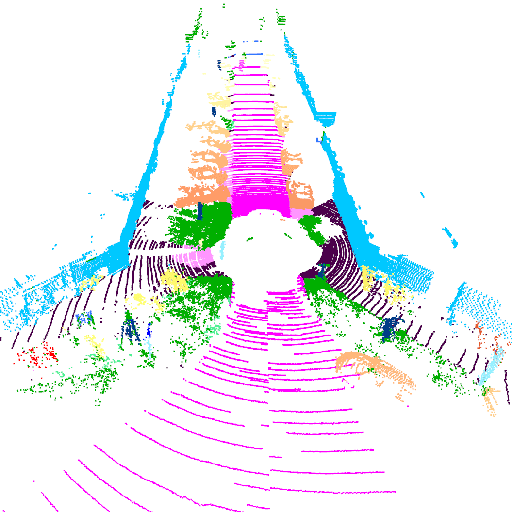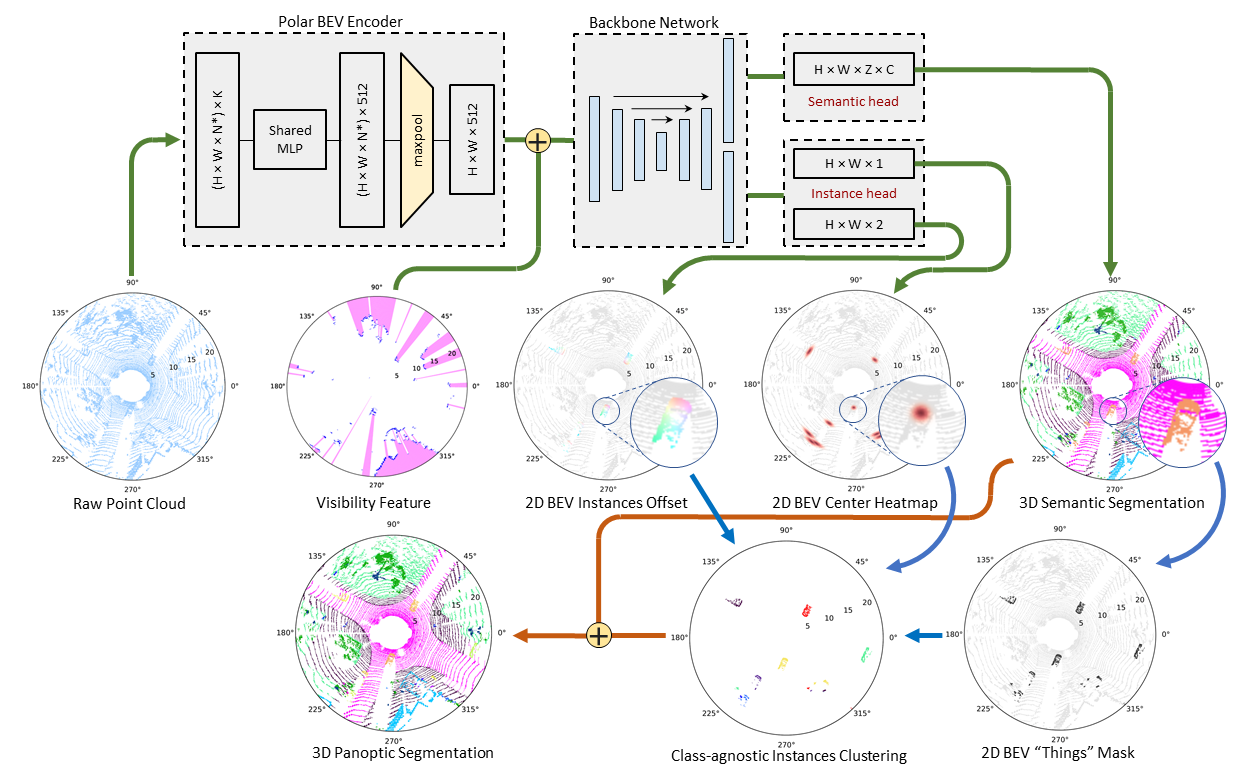Panoptic-PolarNet

Panoptic-PolarNet is a fast and robust LiDAR point cloud panoptic segmentation framework. We learn both semantic segmentation and class-agnostic instance clustering in a single inference network using a polar Bird's Eye View (BEV) representation. Predictions from the semantic and instance head are then fused through a majority voting to create the final panopticsegmentation.

We test Panoptic-PolarNet on SemanticKITTI and nuScenes datasets. Experiment shows that Panoptic-PolarNet reaches state-of-the-art performances with a real-time inference speed.

Prepare dataset and environment
This code is tested on Ubuntu 16.04 with Python 3.8, CUDA 10.2 and Pytorch 1.7.0.
1, Install the following dependencies by either pip install -r requirements.txt or manual installation.
- numpy
- pytorch
- tqdm
- yaml
- Cython
- numba
- torch-scatter
- dropblock
- (Optional) open3d
2, Download Velodyne point clouds and label data in SemanticKITTI dataset here.
3, Extract everything into the same folder. The folder structure inside the zip files of label data matches the folder structure of the LiDAR point cloud data.
4, Data file structure should look like this:
./
├── train.py
├── ...
└── data/
├──sequences
├── 00/
│ ├── velodyne/ # Unzip from KITTI Odometry Benchmark Velodyne point clouds.
| | ├── 000000.bin
| | ├── 000001.bin
| | └── ...
│ └── labels/ # Unzip from SemanticKITTI label data.
| ├── 000000.label
| ├── 000001.label
| └── ...
├── ...
└── 21/
└── ...
5, Instance preprocessing:
python instance_preprocess.py -d </your data path> -o </preprocessed file output path>
Training
Run
python train.py
The code will automatically train, validate and save the model that has the best validation PQ.
Panoptic-PolarNet with default setting requires around 11GB GPU memory for the training. Training model on GPU with less memory would likely cause GPU out-of-memory. In this case, you can set the grid_size in the config file to [320,240,32] or lower.
Evaluate our pretrained model
We also provide a pretrained Panoptic-PolarNet weight.
python test_pretrain.py
Result will be stored in ./out folder. Test performance can be evaluated by uploading label results onto the SemanticKITTI competition website here.
Citation
Please cite our paper if this code benefits your research:
@inproceedings{Zhou2021PanopticPolarNet,
author={Zhou, Zixiang and Zhang, Yang and Foroosh, Hassan},
title={Panoptic-PolarNet: Proposal-free LiDAR Point Cloud Panoptic Segmentation},
booktitle = {Proceedings of the IEEE/CVF Conference on Computer Vision and Pattern Recognition (CVPR)},
year={2021}
}
@InProceedings{Zhang_2020_CVPR,
author = {Zhang, Yang and Zhou, Zixiang and David, Philip and Yue, Xiangyu and Xi, Zerong and Gong, Boqing and Foroosh, Hassan},
title = {PolarNet: An Improved Grid Representation for Online LiDAR Point Clouds Semantic Segmentation},
booktitle = {Proceedings of the IEEE/CVF Conference on Computer Vision and Pattern Recognition (CVPR)},
month = {June},
year = {2020}
}








